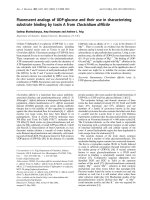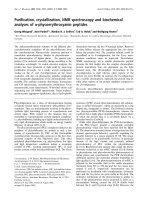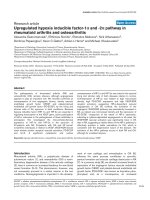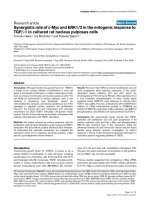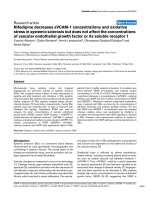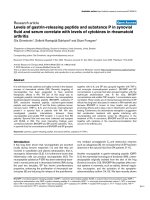Báo cáo y học: " High blood pressure, antihypertensive medication and lung function in a general adult population"
Bạn đang xem bản rút gọn của tài liệu. Xem và tải ngay bản đầy đủ của tài liệu tại đây (254.94 KB, 8 trang )
RESEARCH Open Access
High blood pressure, antihypertensive medication
and lung function in a general adult population
Eva Schnabel
1,2*
, Stefan Karrasch
3,4,5
, Holger Schulz
1,3,5
, Sven Gläser
6
, Christa Meisinger
7,11
, Margit Heier
7,11
,
Annette Peters
8,11
, H-Erich Wichmann
1,8
, Jürgen Behr
5,9
, Rudolf M Huber
5,10
and Joachim Heinrich
1
, for
for the Cooperative Health Research in the Region of Augsburg (KORA) Study Group
Abstract
Background: Several studies showed that blood pressure and lung function are associated. Additionally, a
potential effect of antihypertensive medication, especially beta-blockers, on lung function has been discussed.
However, side effects of beta-blockers have been investigated mainly in patients with already reduced lung
function. Thus, aim of this analysis is to determine whether hypertension and antihypertensive medication have an
adverse effect on lung function in a general adult population.
Methods: Within the population-based KORA F4 study 1319 adults aged 40-65 years performed lung function tests
and blood pressure measurements. Additionally, information on anthropometric measurements, medical history
and use of antihypertensive medication was available. Multivariable regression models were applied to study the
association between blood pressure, antihypertensive medication and lung function.
Results: High blood pressure as well as antihypertensive medication were associated with lower forced expiratory
volume in one second (p = 0.02 respectively p = 0.05; R
2
: 0.65) and forced vital capacity values (p = 0.01
respectively p = 0.05, R
2
: 0.73). Furthermore, a detailed analysis of antihypertensive medication pointed out that
only the use of beta-blockers was associated with reduced lung function, whereas other antihypertensive
medication had no effect on lung function. The adverse effect of beta-blockers was significant for forced vital
capacity (p = 0.04; R
2
: 0.65), while the association with forced expiratory volume in one second showed a trend
toward significance (p = 0.07; R
2
: 0.73). In the same model high blood pressure was associated with reduced
forced vital capacity (p = 0.01) and forced expiratory volume in one second (p = 0.03) values, too.
Conclusion: Our analysis indicates that both high blood pressure and the use of beta-blockers, but not the use of
other antihypertensive medication, are associated with reduced lung function in a general adult population.
Background
Hypertension is an increasingly important public health
challenge worldwide and it is one of the major causes
for morbidity and mortality [1]. Thus, the National High
Blood Pressure Education Program reports that the glo-
bal burden of hypertension is approximately 1 billion
individuals and that more than 7 million deaths per year
may be attributable to hypertension [2].
Moreover, hypertension has been linked to multiple
other diseases including cardiac, cerebrovascular, renal
and eye diseases [3]. Beside the well-established associa-
tion between hypertension and vascular comorbidities,
several studies showed that blood pressure and lung func-
tion are associated [4-9]. It could be demonstrated that
higher forced vital capacity (FVC) is a negative predictor
of developing hypertension [7,8]. Moreover, some studies
found an association between reduced pulmonary func-
tion, including both low FVC and low forced expiratory
volume in one second (FEV
1
), and hypertension [5,9,6].
Furthermore,thereareanumber of publications dis-
cussing the controversial effect of beta-blockers (BBL) on
lung function [10-16]. It is well established that BBL,
even relatively cardioselective agents, can produce
bronchoconstriction and thereby worsen respiratory
* Correspondence:
1
Helmholtz Zentrum München, German Research Center for Environmental
Health, Institute of Epidemiology, Neuherberg, Germany
Full list of author information is available at the end of the article
Schnabel et al. Respiratory Research 2011, 12:50
/>© 2011 Schnabel et al; licensee BioMed Central Ltd. This is an Open Access article distributed under the terms of the Creative
Commons Attribution License ( which permits unrestricted use, distribution, and
reproduction in any medium, provided the original work is properly cited.
flows and symptoms in patients with asthma or chronic
obstructive pulmonary disease (COPD) [10,16,12]. How-
ever, two recent studies suggested that the treatment of
cardiovascular diseases with cardioselective BBL, may
reduce morbidity and mortality in patients with COPD
[11,15]. Two systematic reviews of randomized controlled
trials showed that the use of cardioselective BBL in
patients with asthma or COPD has no adverse effects on
lung function or respiratory symptoms [13,14]. However,
these studies investigated the potential effect of BBL
intake on lung function mainly in patients with already
existing pulmonary diseases. The association between
blood pressure, antihypertensive drug treatment and
limited lung function in a population-based setting is
much less investigated. Thus, the aim of this analysis is
to determine whether hypertension as well as antihyper-
tensive medication has an adverse effect on lung function
in a general adult population.
Methods
Study population
TheKORAF4studyisafollow-upoftheKORAS4
study, a population-based health survey conducted in
the city of Augsburg and two surrounding counties
between 1999 and 2001. A total sample of 6640 subjects
was drawn from the target population consisting of all
German residents of the region aged 25 to 74 years.
Of all 4261 participants of the S4 baseline study, 3080
also participated in the 7-year follow-up F4 study. Per-
sons were considered ineligible for F4 if they had died in
the meantime (n = 176, 4%), lived outside the study
region or were completely lost to follow-up (n = 206,
5%), or had demanded deletion of their address data (n =
12, 0.2%). Of the remaining 3867 eligible persons, 174
could not be contacted, 218 were unable to come because
they were too ill or had no time, and 395 were not willing
to participate in this follow-up, giving a response rate of
79.6%. Our study focuses on a subset of 1319 persons
aged 40-65 years, because only this age-restricted subset
performed both blood pressure measurements and lung
function tests. The clinical examinations and interviews
were performed at the same day. Overall, the KORA F4
study was conducted between 2006 and 2008.
The investigations were carried out in accordance with
the Declaration of Helsinki, including written informed
consent of all participants. All study methods were
approved by the ethics committee of the Bavarian
Chamber of Physicians, Munich.
Outcome assessment
Lung function
Lung function examinations,i.e.spirometry,werecon-
ducted based on the American Thoracic Society (ATS)
criteria [17] and the recommendations of the European
Community for Steel and Coal (ECCS) [18]. The partici-
pants performed at least three forced expiratory lung
function manoeuvres in order to obtain a minimum of
two acceptable and reproducible values. Before the tests
the examiner demonstrated the correct performance of
the manoeuvres and then the individuals were super-
vised throughout the tests. According to the ATS
recommendations [17] the tests were performed in a sit-
ting position and with wearing noseclips. The best
results for FVC and FEV
1
were taken and percent pre-
dicted values were calculated according Quanjer et al.
[18].
Blood pressure, medication and other determinats
Blood pressure was measured using a validated automatic
device (OMRON HEM 705-CP). Three independent blood
pressure measurements were taken with a 3-minute pause
after a rest of at least 5 minutes in a sitting position on the
right arm. The mean of the last two measurements was
used for the current analyses. High blood pressure (HBP)
was defined as blood pressure ≥ 140 mm Hg systolic or
90 mm Hg diastolic (with or without antihypertensive
medications). Additionally, anthropometric measurements,
computer-assisted standardized interviews and self-
administered questionnaires on lifestyle and health related
factors, medical history and respiratory symptoms were
performed. Cardiovascular (heart attack, stroke) and pul-
monary diseases (asthma, chronic bronchitis) were based
on self-reported physician’s diagnosis. The smoking status
(current, former, or never-smokers) was assessed by self-
report. Education level was defined by the highest gradua-
tion (less than O-level, O-level and more than O-level).
Furthermore, the use of medication within the last seven
days before the examination was ascertained by an instru-
ment for database-assisted online collection of medication
data (IDOM) [19]. The following substance classes were
considered as antihypertensive medication according to
the recommendations of the German Hypertension Asso-
ciation [20]: Antihypertensives (ATC code C02), diuretics
(ATC code C03), beta-blocker (ATC code C07), calcium
antagonists (ATC code C08), ACE inhibitors and angio-
tensin antagonists (ATC code C09). Finally, the following
classes of high blood pressure based on the blood pressure
measurement (HBP ≥ 140/90 mmHg) and antihyperten-
sive medication were defined:
- A. HBP: high blood pressure regardless of its medi-
cal treatment
- B. HBP or medication: high blood pressure or the
use of antihypertensive medication
- C. HBP and medication: high blood pressure and
the use of antihypertensive medication; treated but
uncontrolled hypertension
-D.OnlyHBP:highbloodpressure,butnoantihy-
pertensive medication; untreated hypertension
Schnabel et al. Respiratory Research 2011, 12:50
/>Page 2 of 8
- E. Only medication for HBP: antihypertensive med-
ication, but no high blood pressure; treated and
controlled hypertension
- F. Medication for HBP: antihypertensive medica-
tion independent of high blood pressure
Statistical analyses
Descriptive analysis for the study population, blood pres-
sure and lung function measures was done using chi-
square and Kruskal Wallis tests to determine significance
levels. Kruskal-Wallis tests and multivariable linear regres-
sion models were applied to study the association between
the abovementioned classes of high blood pressure and
antihypertensive medication and lung function outcomes.
Additionally, high blood pressure and antihypertensive
medication were used as individual variables in one regres-
sion model. P-values < 0.05 were considered statistically
significant for all analyses. All statistical analysis was
performed with SAS, version 9.13.
Results
Table 1 shows gender-specific characteristics of the 1319
participants with complete data on lung function tests
and blood pressure measurements. Women had a signifi-
cantly lower body mass index (BMI), smoked less and
their blood pressure readings and absolute lung function
values were lower, whereas their percent predicted lung
function values were higher compared to men (p < 0.01
for each comparison). Overall high blood pressure was
less prevalent in women compared to men (10.3% versus
23.1%; p < 0.01). However, for the use of antihypertensive
medication there was no difference between women and
men.
In subjects with high blood pressure FEV
1
% predicted
(105.8 ± 16.0 versus 109.3 ± 16.9; p < 0.01) and FVC %
predicted (111.6 ± 14.8 versus 117.0 ± 15.5; p < 0.01) were
significant lower (Table 2). A similar significant difference
of FEV
1
% predicted (105.4 ± 16.4 versus 109.5 ± 16.8; p <
0.01) and of FVC % predicted (111.9 ± 16.1 versus 117.1 ±
15.3; p < 0.01) could be shown for the use of antihyperten-
sive medication irrespective of high blood pressure.
Furthermore, an effective blood pressure treatment and an
ineffective blood pressure treatment, meaning high blood
pressure despite the use of antihypertensive medication,
were associated with lower FEV
1
% (p = 0.04 and p < 0.01,
respectively) and FVC % predicted values (p = 0.01 and
p < 0.01, respectively).
Similar results for the association between high blood
pressure, antihypertensive medication and lung function
could be shown in men. In women FEV
1
and FVC %
predicted values did not differ between subjects with
and without high blood pressure. However, the use of
antihypertensive medication irrespective of high blood
pressure was associated with a significant reduced FEV
1
and FVC % values in women (p = 0.02 and p < 0.01,
respectively).
The descriptive analysis (Table 2) of the association
between lung function and antihypertensive medication
showed that both BBL and other antihypertensive medi-
cation, as for example ACE inhibitors, angiotensin
antagonists, diuretics or calcium antagonist, are asso-
ciated with reduced FEV
1
and FVC % predicted values
(p = 0.01 and p < 0.01, respectively).
The application of multivariable regression models
revealed that high blood pressure as well as antihyperten-
sive medication are associated with lower FEV
1
(p = 0.02
and p = 0.05, respectively) and FVC values (p = 0.01 and
p = 0.05, respectively) after adjusting for sex, age, height,
weight, education level, packyears of smoking, pulmonary
and cardiac diseases (Table 3, Model 1 and 3). When
using both high blood pressure and antihypertensive
medication as individual variables in one regression
model, it could be shown, that both variables were asso-
ciated with reduced lung function values (Model 6).
However, antihypertensive medication showed only a
trend toward a significant association with lower FEV
1
and FVC values (each p = 0.08). Furthermore, the
adjusted regression models with mutual exclusive cate-
gories pointed out that the combination of high blood
pressure and the use of antihypertensive medication had
the strongest negative effect on lung function (Model 4).
Thus, among treated but not controlled hypertensive
subjects FEV
1
had a lower volume of 160 mL and FVC of
170 mL compared to subjects with no high blood pres-
sure and no antihypertensive medication (each p = 0.02
and p = 0.02). A detailed analysis of antihypertensive
medication showed that the use of BBL was associated
with reduced FEV
1
and FVC values, whereas other anti-
hypertensive medication had no effect on lung function
(Model 5). However, it has to be considered that the
effect of BBL was significant for FVC (p = 0.03) while for
FEV
1
the association was of borderline significance (p =
0.07). A further model including BBL, other antihyper-
tensive medication and high blood pressure showed simi-
lar negative effects of BBL on FVC (p = 0.04) and FEV
1
(p = 0.07). Besides, high blood pressure was associated
with reduced FVC (p = 0.01) and FEV
1
(p = 0.03) values,
too (Model 5a). An additional sensitivity analysis of the
models 5 and 6, where we excluded subjects with
obstructive lung diseases, showed that the effect of BBL
still exists. Although the significance level declined the
magnitude effect estimates did not change. For all multi-
variable regression models the adjusted r-squared value
was 0.65 for FEV
1
and 0.73 for FVC.
A further sensitivity analysis regarding the possible effect
modification by gender showed no gender difference for
FEV
1
for all models. The multivariable regression models
for FVC, however, showed a significant interaction
Schnabel et al. Respiratory Research 2011, 12:50
/>Page 3 of 8
between gender and high blood pressure, indicating that
high blood pressure has a lower effect on lung function in
women compared to men. Further analyses regarding the
ratio FEV
1
/FVC showed no significant association between
high blood pressure or antihypertensive medication and
the ratio FEV
1
/FVC.
Discussion
The present analysis of a population-based study
demonstrates that both high blood pressure and the use
of BBL are associated with reduced lung function,
whereas other antihypertensive medications have no
effect on lung function.
Our findings are in line with previous observations that
blood pressure and lung function are inversely associated
[5,6,9]. But most of these studies did not differentiate
between the effect of high blood pressure and the effect
of antihypertensive medication on lung function. Instead
they defined hypertension as elevated blood pressure or
use of antihypertensive medication. One study, however,
found no difference in FEV
1
and FVC between hyperten-
sive subjects that used or did not use beta blocking
Table 1 Characteristics of the study population based on KORA F4, persons aged 40-65 years with blood pressure
measurements and lung function tests
Men (N = 618) Women (N = 701)
Mean ± SD Mean ± SD P-Value
#
Age (years) 51.6 ± 5.8 51.5 ± 5.6 0.83
BMI (kg/m
2
) 28.0 ± 4.5 26.9 ± 5.2 <0.01
Packyears (y) 21.8 ± 20.1 13.4 ± 12.9 <0.01
Blood pressure
Mean SBP (mm Hg) 126.3 ± 16.1 114.9 ± 15.8 <0.01
Mean DBP (mm Hg) 80.1 ± 9.8 74.1 ± 9.0 <0.01
Lung function
FEV
1
(l) 3.9 ± 0.7 2.8 ± 0.5 <0.01
FVC (l) 5.0 ± 0.8 3.6 ± 0.6 <0.01
FEV
1
% predicted
$
107.2 ± 16.2 110.1 ± 17.2 <0.01
FVC % predicted
$
111.5 ± 13.7 120.2 ± 16.0 <0.01
n (%) n (%) P-Value
#
Pulmonary and cardiac diseases
Asthma 50 (8.1) 69 (9.8) 0.27
Chronic bronchitis 49 (8.0) 58 (8.3) 0.81
Heart attack 17 (2.8) 11 (1.6) 0.14
Stroke 15 (2.4) 2 (0.3) <0.01
Smoking status
current 155 (25.1) 150 (21.4) 0.11
former 268 (43.4) 236 (33.7) <0.01
never 195 (31.6) 315 (45.0) <0.01
High blood pressure and medication*classes
HBP 143 (23.1) 72 (10.3) <0.01
HBP or medication* 221 (35.8) 177 (25.3) <0.01
HBP and medication* 46 (7.4) 22 (3.1) <0.01
Only HBP 97 (15.7) 50 (7.1) <0.01
Only medication*for HBP 78 (12.6) 105 (15.0) 0.22
Medication* for HBP 124 (20.1) 127 (18.1) 0.37
Beta-blocker 68 (11.4) 82 (11.8) 0.67
ACE inhibitor 52 (8.4) 44 (6.3) 0.14
Angiotensin antagonists 41 (6.6) 33 (4.7) 0.13
Diuretics 63 (10.2) 60 (8.6) 0.32
Calcium antagonists 25 (4.1) 25 (3.6) 0.65
Other antihypertensive drugs 3 (0.5) 4 (0.6) 0.83
SBP: systolic blood pressure; DBP: diastolic blood pressure; HBP: high blood pressure.
(≥140/90 mmHg); FEV
1
: forced expiratory volume in one second; FVC: forced vital capacity.
*Medication: antihypertensive medication;
$
% predicted values according to Quanjer;
#
Obtained from the chi-square test when comparing frequencies and from
the Kruskal Wallis test when comparing mean values.
Schnabel et al. Respiratory Research 2011, 12:50
/>Page 4 of 8
antihypertensives [6], but they did not specifically address
the effect of antihypertensive medication independent of
high blood pressure on lung function.
Thus, our study might substantially add to the question,
whether antihypertensive BBL medication independent of
high blood pressure has adverse effects on lung function.
Beta-adrenergic receptors (b-ARs) play a key role in the
regulation of bronchomotor tone [21]. In the respiratory
system most of the b-ARs are b2-ARs. However, there are
b1-ARs, too, which are responsible for the respiratory
effects of cardioselective b1-antagonists. Two systematic
reviews suggest that cardioselective BBL do not produce
adverse respiratory effects in patients with asthma or
COPD [13,14]. These randomized clinical trials examined
only patients with already existing pulmonary diseases and
not healthy subjects. Other studies provide evidence that
BBL medication, even relatively cardioselective agents,
produce bronchoconstriction and thereby worsen respira-
tory flows in asthmatic patients [10,16]. Our results indi-
cate that the use of BBL medication is associated with a
slight reduction of FEV
1
and FVC. Interestingly, the FEV
1
/
FVC ratio was found not to be affected by BBL medication
suggesting that the expired volume, FVC, is lowered in
proportion. Indeed, the drug-specific effect of BBL medi-
cation is more pronounced on FVC than on FEV
1
.This
supports the hypothesis that not airway obstruction, but
rather restriction is the more likely mechanism involved
in the effect of BBL medication on lung function. For
instance, possible effects on the respiratory muscle
strength have to be considered. It is well established that
beta agonists improve the performance of skeletal muscles
[22] and also positively affect respiratory muscle strength
[23,24]. The opposite effect by BBL medication is sug-
gested by a recent study from Frankenstein et al. per-
formed in patients with chronic heart failure [25]. Thus,
we hypothesize that BBL medication may result in a slight
reduction of expiratory muscle strength causing a propor-
tional decrease of FEV
1
and FVC. However, further studies
directly addressing this issue are required.
When reviewing our results, it becomes apparent that
from a statistical point of view both high blood pressure
and antihypertensive BBL medication have an effect on
lung function measurements. But the observed lung func-
tion differences between exposed und non-exposed sub-
jects are relatively small, meaning that they have no direct
clinical consequence in healthy individuals. However, we
could show that among treated but not controlled hyper-
tensive subjects FEV
1
had a lower volume of 160 mL com-
pared to subjects with no high blood pressure and no
antihypertensive medication. This finding might be of
importance on the population level. One possible explana-
tion for this significant lung function reduction might be
Table 2 Crude association between high blood pressure, antihypertensive medication and lung function
N FEV
1
%
$
P-Value
#
FVC %
$
P-Value
#
HBP
Yes 215 105.8 ± 16.0 <0.01 111.6 ± 14.8 <0.01
No 1104 109.3 ± 16.9 117.0 ± 15.5
HBP or medication*
Yes 398 106.0 ± 16.3 <0.01 112.3 ± 15.4 <0.01
No 921 109.9 ± 16.9 117.8 ± 15.3
HBP and medication*
Yes 68 103.1 ± 15.7 <0.01 108.5 ± 15.8 <0.01
No 1251 109.1 ± 16.8 116.6 ± 15.4
Only HBP
Yes 147 107.0 ± 16.0 0.19 112.9 ± 14.2 0.01
No 1172 109.0 ± 16.9 116.5 ± 15.7
Only medication* for HBP
Yes 183 106.3 ± 16.7 0.04 113.2 ± 16.0 0.01
No 1136 109.2 ± 16.8 116.6 ± 15.4
Medication* for HBP
Yes 251 105.4 ± 16.4 <0.01 111.9 ± 16.1 <0.01
No 1068 109.5 ± 16.8 117.1 ± 15.3
Medication* for HBP
Beta-blocker 150 105.8 ± 16.1 0.01 112.0 ± 15.7 <0.01
Other antihypertensive drugs 101 104.9 ± 16.9 0.01 111.7 ± 16.7 <0.01
No antihypertensive drugs 1068 109.5 ± 16.8 117.1 ± 15.3
HBP: high blood pressure (≥140/90 mmHg); FEV
1
: forced expiratory volume in one second; FVC: forced vital capacity; *Medication: antihypertensive medication;
$
% predicted values according to Quanjer: mean ± standard deviation;
#
Obtained from Kruskal Wallis Test.
Schnabel et al. Respiratory Research 2011, 12:50
/>Page 5 of 8




